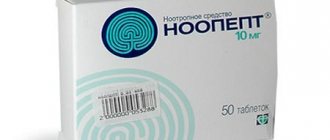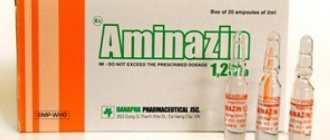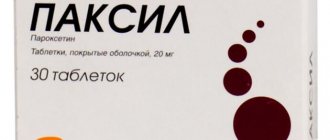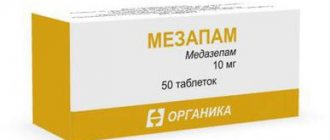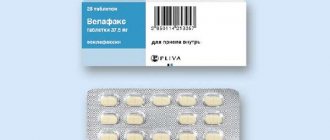Release form and composition
This drug is produced in two pharmacological forms: tablets and in the form of a solution for intramuscular injection.
Tablets are available in volumes of 25 and 100 mg containing the active ingredient of the same name, round in shape, yellow in color. The auxiliary components are: corn starch, povidone, lactose, magnesium stearate, talc, colloyl silicon dioxide.
The injection solution contains 2.5% of the active substance and is packaged in glass ampoules in a volume of 2 ml.
Reasons for using the drug in drug addicts
The pronounced sedative, inhibitory effect of Clozapine has long been known among drug addicts. The drug’s ability to enhance the effect of using other types of illegal drugs (depressants) is also used to obtain euphoria. This drug is used much more often than other antipsychotics for recreational purposes.
Clozapine's ability to make it easier to fall asleep is known among drug addicts. They often cannot rest fully at night, and widely use this antipsychotic to eliminate insomnia. In addition to the mixture, underground manufacturers of synthetic substances may use Azaleptin or another type of antipsychotic to potentiate the effect. They care little about the consumer's health; making a profit is much more important to them.
In terms of the degree of anticholinergic effect on the body, Clozapine is often compared with Tropicamide. The latter remedy comes in the form of drops and is considered by many as a cheap type of drug. Since 2013, Azaleptin has been included in the list of potent drugs in the Russian Federation. Its sale without a special prescription form is prohibited by law.
Indications for use
Direct indications for the use of this drug are diseases and conditions such as:
- psychomotor agitation due to schizophrenia;
- hallucinatory-delusional states, including visions that acquire the character of reality and delirium;
- worsening mood;
- other psychopathic diseases.
Azaleptin in the treatment of alcoholism
The issue of taking Azaleptin in the treatment of alcoholism deserves special attention. This drug does not affect the craving for alcohol. One of the features of chronic alcohol dependence is that without a dose of alcohol a person becomes depressed. He experiences a very difficult emotional state, which may be accompanied by outbursts of aggression, destructive behavior or even psychosis.
At the same time, it is very important to understand that psychoses and hallucinations caused by alcohol are in no way treated with Azaleptin; it can only be taken when alcohol is completely removed from the body. This is due to the fact that Azaleptin and alcohol are completely incompatible
In fact, most medications are not compatible with alcohol, and many are convinced from their own experience that negative consequences do not always occur. For example, many drank alcohol while taking antibiotics - and nothing happened. Hence, people form the opinion that incompatibility with alcohol is nothing more than a “horror story.” In reality, different drugs interact with ethanol differently, and
In very small doses, alcohol excites the nervous system: a person feels cheerful and energetic, and their mood improves. However, the larger the dose, the more the nervous system is inhibited and depressed; large doses of alcohol lead to a person becoming lethargic, slowly reacting to external stimuli, and all emotions are dulled.
https://www.youtube.com/watch?v=mhlG9ICpVl0
Azaleptin also depresses the nervous system, and it acts quite quickly. Both alcohol and Azaleptin are broken down in the liver. When these two substances “meet” in the body, the load on the liver increases greatly, and the liver “puts” them in a queue, not being able to process both at the same time.
Depending on the characteristics of the body and the concentration of substances that suppress the nervous system, the consequences may be different. In a mild case, there may be severe intoxication, accompanied by vomiting, heart rhythm disturbances, and hallucinations. Such poisoning will have to be treated only in a hospital, under the supervision of doctors, and liver function will need to be restored separately.
The incompatibility of Azaleptin with alcohol casts doubt on the advisability of using this drug for the treatment of alcoholism. If a person takes such a strong antipsychotic at home, there is no guarantee that he will not have a breakdown and will not drink. In order to reduce the risks of such actions to zero, it is better to prescribe Azaleptin only if the treatment of alcoholism takes place in a special clinic, where a person, even if they want, does not have access to alcohol and the opportunity to drink.
Contraindications
This drug has a number of contraindications for its use in any form. These will include:
- epilepsy;
- glaucoma;
- cardiovascular diseases;
- intoxication psychosis;
- alcoholic psychosis in acute form;
- spasmophilia;
- intestinal atony;
- prostate adenoma;
- pregnancy period in the first trimester;
- individual hypersensitivity to any of the components that make up this drug.
Indications and contraindications for taking Azaleptin
Azaleptin is very often used in medical practice to treat various types and origins of nervous and mental disorders. Indications for use of the product include:
schizophrenia, acute or chronic;
- manic tendencies;
- manic-depressive states;
- psychomotor agitation;
- psychopathy accompanied by psychomotor agitation;
- sleep disorders;
- behavioral disorders.
It is prohibited to take the drug if:
- hypersensitivity to the composition of the drug;
- low levels of blood granulocytes;
- disorders of the bone marrow;
- psychoses associated with the use of alcohol or toxic substances;
- drug poisoning;
- myasthenia gravis;
- infectious diseases;
- comatose states.
Under the constant supervision and supervision of a physician, treatment should be carried out in persons with impaired functions of the cardiovascular system, liver, kidneys, with closed-angle glaucoma, prostate diseases, lack of intestinal motility, epilepsy, intercurrent diseases with febrile syndrome. For kidney and liver diseases, the dose should be reduced to 20-200 mg per day.
Azaleptin is strictly prohibited for pregnant women and breastfeeding women due to the possibility of a toxic effect of the drug on the child. Treatment of children under 5 years with the drug is also prohibited. The effect on children under 16 years of age has not been fully studied.
During the first time after starting to take the medicine, constant monitoring of the patient’s blood tests and his general condition is carried out. When using the medication, it is recommended to refrain from driving vehicles and activities that require increased attention. It is strictly prohibited to drink alcohol during the treatment period.
Directions for use and dosage
The tablet form of Clozapine should be taken regardless of meal times. The recommended single dosage is 50-100 mg. The frequency of administration is usually 2-3 times a day. If necessary, the doctor may prescribe an increased daily dosage of 200-600 mg. Maintenance therapy with this drug is carried out at a dosage of 25-200 mg once a day (in the evening, before bedtime).
This drug is administered intramuscularly once a day, in the evening, before bedtime, in a volume of no more than 1-2 ml.
Clozapine (azaleptin, leponex)
A new series of psychotropic drugs—atypical antipsychotics—begins with clozapine. Today the drug is used to treat resistant schizophrenia, overcome suicidal thoughts and suicidal behavior in schizophrenia and schizo-affective disorder, dyskinesia, treat psychosis in Parkinson's disease and dementia with Lewy bodies, treat resistant forms of bipolar affective disorder, relieve severe psychosis and treat post-traumatic stress syndrome disorders. Clozapine is a derivative of dibenzodiazepine with high affinity for 5-HT2, alpha 1/2, M1-M5, and H1 receptors, moderate activity at D2/D4 receptors. Its antipsychotic effect (positive symptoms) is probably due to antagonism towards D2 receptors, and the relief of negative symptoms is due to 5-HT2A receptors. Typically, the effect of clozapine appears within a few days, but a delayed effect is also possible - for weeks or even months, which is mainly achieved by correct dose selection. For long-term therapy, low doses are used, monitoring the concentration of the drug in the blood. Large doses of the drug are most often ineffective. Some drugs, such as dopamine agonists or amantadine, may partially counteract the effect of clozapine. Since the drug affects the activity of the heart and the number of neutrophils, it is recommended to do an ECG once every six weeks (danger of cardiomyopathy) and look at a general blood test.
Side effects of the drug include: weight gain, excessive sedation (blockade of H1 receptors), impaired motor function (blockade of D2 receptors). Reduced blood pressure (blockade of alpha-1/2 receptors), dry mouth, constipation (blockade of muscarinic receptors - anticholinergic effect). Less common side effects are hypersalivation, headache, tremor, tachycardia, orthostatic hypotension, urinary retention, fever, constipation, nausea. Typically, the drug is initially prescribed, starting with a dose of 12.5 mg twice a day, for acute psychosis or mania, then increasing every two days by 25 - 50 mg. Pharmacokinetics: metabolism in the liver via CYP1A2 (mainly) and CYP3A4, Cyp2D6. The half-life is 8-12 hours, the peak is after 2.5 hours. The drug is withdrawn slowly over 1-2 weeks to avoid relapse of psychosis and cholinergic rebound (diarrhea, headache).
Drug interactions: when combined with potent CYP1A2 (fluvoxamine, verapamil), CYP3A4 (protease inhibitors, clarithromycin, ketoconazole, nefazadone) and CYP2D6 (fluoxetine, paroxetine, bupropion), as well as taking caffeine, the level of clopixol in the blood increases. Valproate and smoking reduce plasma levels of clopixol. When combined with antihypertensive drugs, blood pressure may decrease to a greater extent. The combination of clopixol with CYP3A4 inducers: carbamazepine, phenytoin, corticosteroids) is not recommended. The drug should not be prescribed for glaucoma and enlarged prostate, and especially for myeloproliferative disorders and depression (suppression) of the central nervous system. The risk of anticholinergic toxicity increases with older age.
Side effects
Clozapine may cause some negative side effects. So against the background of its use the following may appear:
- dry mouth;
- rave;
- confusion;
- drowsy state;
- muscle weakness;
- orthostatic hypotension;
- tachycardia;
- increase in body temperature;
- collapsed state;
- violation of accommodation.
At the first signs of the development of agranulocytosis, therapy with this drug should be immediately discontinued.
Interaction with other tools
Azaleptin interacts with medications. To exclude complications, it is necessary to tell the doctor about all the medications used by the patient.
- The medicine should not be taken simultaneously with substances that depress the central nervous system. These include haloperidol, caffeine, narcotics, and tranquilizers. They increase the risk of side effects, causing shortness of breath and difficulty breathing.
- Clozapine enhances the effect of sleeping pills, so when taken together, you must scrupulously follow your doctor's prescriptions.
- The use of Azaleptin together with valproic acid and Risperidone disrupts the metabolism of the main active substance and increases its concentration in the blood.
- Combination with lithium carbonate threatens deterioration of mental stability, convulsions and headaches.
special instructions
This drug has a direct effect on a person’s psychomotor reactions, and therefore, during its use, activities associated with complex mechanisms, including driving vehicles, should be limited.
This drug must be prescribed by your doctor. In cases of inadequate reactions of the body to the drug, consultation with a doctor is also required.
General information about the drug
The drug Clozapine is produced both by a domestic manufacturer and by foreign pharmaceutical companies (Salutas Pharma GmbH, Germany and Maxpharma, India, etc.). The medication has a sedative and antipsychotic effect.
Clozapine is a neuroleptic. This group of drugs is traditionally used to treat various types of mental disorders. The international nonproprietary name of the drug is Clozapine, used in psychiatry.
Release forms and prices for the drug, average in Russia
The medicine is produced in tablets, which are in a bottle or blister. The average price of Clozapine is 500 rubles. However, it may vary depending on the dosage. Clozapine is mainly produced in 25 or 100 mg of active ingredient in one tablet. The above shows the cost of products with a lower dosage. After reviewing the table, you can compare the prices of Clozapine and the most common analogues.
| Tradename | Cost, rub. |
| Zalasta | 1300 |
| Quentiax | 1200 |
| Quetiapine | 1000 |
| Closasten | 1500 |
| Olanzapine | 280 |
| Risperidone | 150 |
Prices for the listed drugs may also vary depending on the dosage.
Composition, pharmacodynamics and pharmacokinetics
The main active component of this drug is clozapine, which is a tricyclic benzodiazepine derivative. The composition also contains auxiliary substances such as cellulose, lactose, starch and others.
The action of the drug is based on blocking the following receptors:
- dopamine type 4;
- serotonin type 2A;
- muscarinic acetylcholine;
- alpha adrenergic receptors type 1.
Effect of the drug
Absorption of the drug occurs in the gastrointestinal tract. In total, about 95% of the active component is absorbed, and food intake does not affect this indicator. After entering the blood, the drug binds to albumin and is delivered to the liver, where the drug is metabolized. The maximum concentration of the active substance in the body is achieved within 2.5 hours after taking the tablets. Most of the drug is excreted in the urine and less in the feces.



